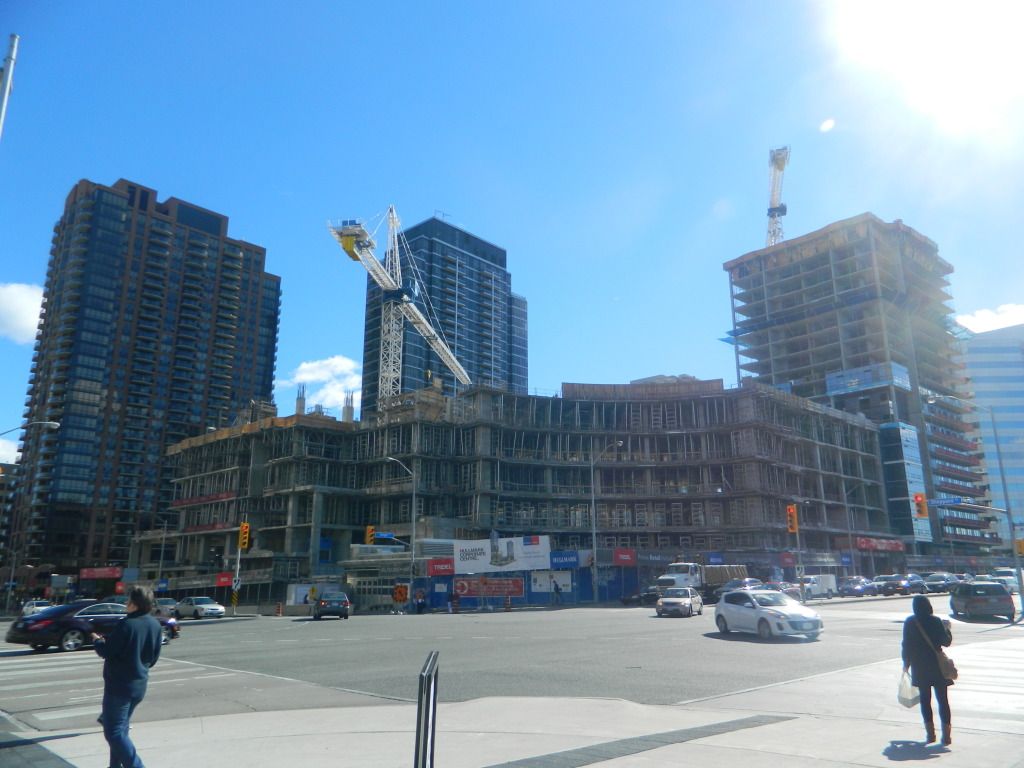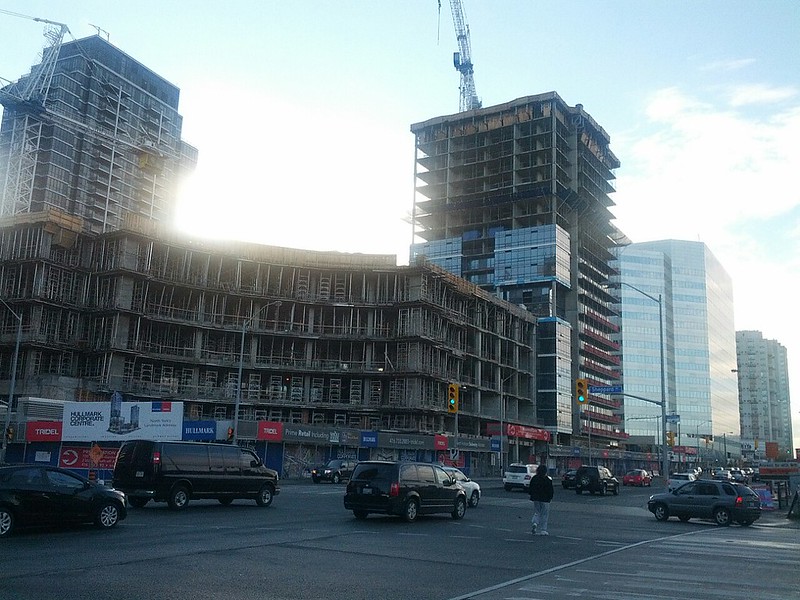You think NYCC shouldn't have been a high density mobility hub?! Think of the alternative, which is to house all those people and businesses in car-dependant subdivisions or office parks. North York Centre is known across the continent as one of the most successful suburban downtowns. The Hullmark Centre competes far more effectively against them than do condos and offices downtown.
My beef is they increased the population density in NYCC without adding adequate infracture to support all those extra people. Say each condo has 1,000 residents,.... there's been about 50 new condos since amalgamation in NYCC,... that amounts to 50,000 new residents (oh, and that`s not even including conversion of postwar bungalows to higher density McMansions and townhouses),.... and most condo dwellers are young working type with 9-5 jobs,... meaning a lot of them are in the cars in rush hour traffic or on an already 100% full capacity Yonge subway train that is already packed when it leaves Yonge-Sheppard station.
You`re talking about narrowing streets to force people to use public transit or bike. People should have a choice in what mode of transportation they use. They shouldn`t be forced to use an inadequate transit system or bike in the winter. Yes, the TTC is inadequate,... travel anywhere in the world and you`ll see how inadequate the TTC is. TTC bus and streetcar rarely operate on-schedule and when they do arrive, you can expect bunching with the first one packed with standing room only,... subways are not much better with all their frequent service desruptions.
We already have the worst traffic congestion in North America,... mainly because idealistic politicians have been trying to force us out of our cars,... and onto an inadequately funded public transit system.
Wider roads ensures more growth and more room for not only cars, but also transit, cyclist and pedestrians. Wider roads allow for transit only Right Of Way bus/LRT lanes and bike lanes.
Look at those narrow downtown streets like King, Queen, Dundas or College,... they don't function well at all.
There certainly should have built more infrastructure, namely the Downtown Relief Line to deal with Yonge line overcrowding. Wider roads would only have made traffic worse by hampering alternative modes. They make walking less attractive by separating buildings, being noisy and hard to cross. They also make transit and cycling less attractive by generally being unpleasant.
BTW,.... there already is a DowntownReliefLine,.... it`s called the University-Spadina subway line,... it's runs basically parallel and is 0.6-4.4km to the west of the Yonge subway line. How much will another DRL cost,.... and it will service neighbourhoods that are already serviced by public transit. Sure these neighbourhoods will get faster and better transit,... but there are lots of neighbourhoods in Toronto that does not have adequate public transit. Priorities need to be set with a focus using tax dollar wisely.
The best way to alleviate overcrowding on the Yonge subway line is to make more efficient use of current infrastructure. Instead of having subway train run every 2.5-5 minutes,... Automatic Train Control will allow them to operate every 1.5-3 minutes,... thus increasing capacity. Most modern subway system in the world operate with 1-2 minutes between subways trains.
As someone who has used that trail numerous times to get from my house in Vaughan to NYCC, I can say it is fairly reasonable as a transport corridor. As you say, it would really benefit from better link into the Centre of NYCC, and that is exactly what I said we should build. Doris and Beecroft would be great as paired one-ways, with Beecroft being southbound and Doris being northbound. That way there would be space freed up for bike paths along either Yonge or both Beecroft and Doris.
It's true that the 401 poses a huge barrier for walking and cycling, but a huge portion of travel is in directions not affected by it.
If you`re all for narrow streets, high density condos, anti-cars, pro-transit, pro-cycling,..... why do you live in a house in Vaughan??? Vaughan is the exact opposite,... Vaughan is full of wide open streets, large homes on large lots suburban sprawl, poor public transit and not bike friendly,....
When you`re biking in from Vaughan, do you come down Beecroft or Doris,.... or god-forbid Yonge Street,..
One way streets along Doris and Beecroft is an interesting idea. But I don't think it'll fly in NYCC,... one way streets generally work well on downtown narrow streets where you need to restrict traffic flow because the streets are generally too narrow to handle two-way traffic adequately. The original intent of Doris and Beecroft was to provide a north-south artery to service the condos and offices in NYCC and would alleviate traffic on Yonge Street. One way streets along Doris and Beecroft would encourage traffic to use Yonge Street and promote a lot of east-west traffic,.... crossing Yonge Street.
Also, most condos are on east side of Yonge Street,... closer to Doris,.... and in the morning many of these condo dwellers are heading southbound to the 401,... thus southbound one way on Doris in AM,... and northbound Doris in PM,... but that would be confusing.
By getting rid of the street parking on Beecroft, there would be room for bike lanes. There`s already a number of green P parking facilities on Beecroft,... Since Doris does not have on street parking lanes, bike lanes might be possible by paving over those strip of land between the sidewalk and road which are currently covered with grass. Currently given the choice of one or the other,... the city is more in favour of on road bike lanes along Beecroft.
I don't see why they would need to widen that bridge. Avenue Road pretty much ends there, so there is no need for the big structure they have now. And bike lanes there would do nothing for NYCC since there's a huge valley separating the two.
North of Avenue Road, there`s some residential streets that leads to trails that goes down to the valley below,... it`s a nice recreational ride down there.
Since you`re a cyclist,.... and we don`t have many in NYCC,.... Not that you do, but if you did,.... If you lived in NYCC,... where would you bike to,.... seriously, downtown, midtown, down to the beach or waterfront, up to Vaughan,..... recreational or commuting,... Forget the fact that Yonge-401 is a suicide mission for cyclists,... and forget about the valley, especially having to ride up the valley,... if you lived in NYCC, where would you like to bike to,...








